VMF-132
| Marine Fighting Squadron 132 | |
|---|---|
 VMTB-132 Insignia | |
| Active |
1932–1933 January 1935 - 9 November 1945 |
| Country | United States |
| Branch | USMC |
| Type | Dive Bomber squadron |
| Role |
Reconnaissance Air Interdiction Close air support |
| Part of | inactive |
| Nickname(s) | Crying Red Asses |
| Engagements |
World War II * Battle of Guadalcanal |
| Commanders | |
| Notable commanders | Louis Robertshaw |
Marine Fighting Squadron 132 (VMF-132) was a fighter squadron in the United States Marine Corps. The squadron, also known as “The Crying Red Asses”, fought in World War II as a dive bomber unit during the Battle of Guadalcanal as part of the Cactus Air Force and later fought in the Central Solomon Islands. They were deactivated shortly after the end of the war but were reactivated in the Marine Air Reserve flying out of Floyd Bennett Field in Brooklyn, New York. They were again deactivated sometime after 1958.
History
Marine Bombing Squadron 6 (VB-6M) was formed in San Diego, California in 1932. They were deactivated shortly thereafter in 1933, only to reactivate again in January 1935. The squadron was redesignated as Marine Bombing Squadron 1 (VMB-1) on 1 July 1937.[1] The squadron was again redesignated as Marine Scout Bombing Squadron 132 (VMSB-132) on 1 July 1941.[2] At the outbreak of World War II, the squadron, under the command of Major A.D. Cooley, and its 19 Douglas SBD-1 Dauntless dive bombers were stationed at Marine Corps Air Station Quantico, Virginia as part of Marine Aircraft Group 11.
VMSB-132 left the United States on 13 October 1942 from San Diego aboard the Lurline. At the time of their departure the squadron consisted of 27 officers, 245 enlisted men and a few attached Navy personnel.[3] They landed in Nouméa, New Caledonia on 28 October. On 30 October 1942, VMSB-132, under the command of Major Louis Robertshaw, landed at Henderson Field, Guadalcanal. Upon arrival, they became part of the Cactus Air Force and fought during the Battle of Guadalcanal until December 1942 when they were relieved by VMSB-233. The squadron’s pilots and gunners left the island on 24 December 1942 and arrived in Sydney, Australia for leave on New Year’s Eve.[4] After resting, reorganizing, and retraining, they then moved to Espiritu Santo where they were met by their ground echelon in January 1943. During this time, they became part of the Strike Command of the 13th Air Force, responsible for attacking nearby enemy bases and shipping and giving what was then considered close support to front-line units. The squadron returned to Guadalcanal in June 1943 and flew missions from there until their return to the States on 26 October 1943.
Early in the summer of 1944, the squadron was reorganized and in training at Marine Corps Air Station El Toro as part of Marine Base Defense Air Group 41. On 14 October 1944, the squadron was once again redesignated, this time as VMTB-132. They received their first Grumman TBF Avengers in November of that year. The squadron training at Marine Corps Air Station Mojave, California from 15 December 1944 until January 16, 1945.[5] They remained in training until they embarked on board the USS Cape Gloucester on 21 May 1945.[6] They arrived in Leyte on 29 June 1945 and operated in the East China Sea during July and August 1945.
Following the war, the squadron moved to Marine Corps Air Station Ewa, Hawaii where they were deactivated on 9 November 1945.[1]
Awards
Unit
 Presidential Unit Citation — Guadalcanal/Tulagi (August 7 – December 9, 1942)
Presidential Unit Citation — Guadalcanal/Tulagi (August 7 – December 9, 1942)
Individuals
- Major Joseph Sailer Jr. - awarded the Navy Cross for his actions during the Battle of Guadalcanal from 10–15 November 1942[7]
See also
- United States Marine Corps Aviation
- List of inactive United States Marine Corps aircraft squadrons
- List of United States Marine Corps aircraft squadrons
References
- Notes
- Bibliography
- Crowder, Michael J. (2000). United States Marine Corps Aviation Squadron Lineage, Insignia & History - Volume One - The Fighter Squadrons. Paducah, KY: Turner Publishing Company. ISBN 1-56311-926-9.
- Condon, John Pomeroy (1998). Corsairs and Flattops - Marine Carrier Air Warfare, 1944-45. Annapolis Maryland: Naval Institute Press. ISBN 1-55750-127-0.
- Rottman, Gordon L. (2002). U.S. Marine Corps World War II Order of Battle - Ground and Air Units in the Pacific War, 1939 - 1945.’’. Greenwood Press. ISBN 0-313-31906-5.
- Sherrod, Robert (1952). History of Marine Corps Aviation in World War II. Washington, D.C.: Combat Forces Press.
- Web
- Kernahan, George. "VMSB-132". Curtiss SB2C Helldiver. Archived from the original on 2009-10-25.
- Rentz, John M. "The Role of Aviation". Marines in the Central Solomons. Historical Section, Headquarters Marine Corps.
- Shaw, Henry I. "November and Continuing Buildup". First Offensive: The Marine Campaign for Guadalcanal. Marine Corps History and Museums Division.
- "The Road Back - Guadalcanal". History of Marine Corps Aviation. www.acepilots.com.
- "United States Marine Corps Aircraft, Units, and Locations December 7, 1941". www.bluejacket.com.
